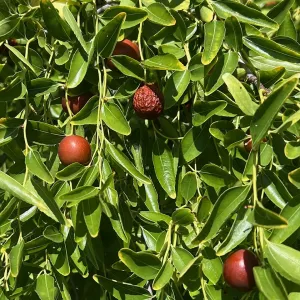Blog by Karen Metz
In early September, I had the opportunity to visit a friend’s house and pick Chinese Jujubes, Ziziphus jujuba. Ziziphus jujuba is native to Asia. The tree was about 12 to 15 feet high. She had been growing the tree for about 12 years. She thought this was about as large as it was going to get. Apparently, in California, the trees do not get as large as they do in Asia or even in Texas.

The leaves were a bright, glossy green. She said they would turn a pretty yellow, later in the fall, before they fell off. Harvest time is usually spread out over several weeks in August and September. You could see the ripening light green fruit, the ripe reddish brown fruit, and then the wrinkling fruit that was drying on the tree. Some varieties are delicious eaten fresh, while others are grown to be used in the dried form.
The fresh fruit is high in Vitamin C and fiber. The fruit is small and tastes like an apple. There is a small central stone that contains 2 seeds, which are discarded. She wasn’t sure what variety she had, but it was delicious eaten fresh. The two most commonly available varieties are 'Li' and 'Lang', but there are many varieties.

According to the California Rare Fruit Growers Organization, jujubes thrive in summer heat and sun. Most varieties are self-fertile. They can be drought-tolerant once established, but will have more fruit with water. They need well-draining soil and have a very low winter chill requirement to set fruit. They can also handle frosts down to negative 30 degrees Fahrenheit.
They also do not seem to have many pests when grown in the United States. The only real issue I could find was that the roots could send up suckers, which sometimes had spurs. If these weren’t dealt with by mowing or hoeing, you could end up with a thicket. My friend has not had an issue with this.
So, this is a lovely small fruit tree that tolerates heat, can handle lower watering, and successfully grows in the backyard. It does not do well in containers. For more information, check out this page from the California Rare Fruit Growers: crfg.org/homepage/library/fruitfacts/jujube


